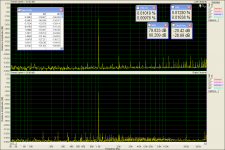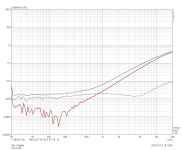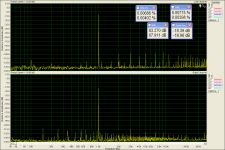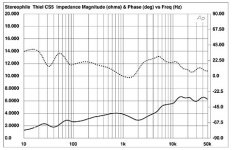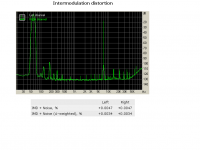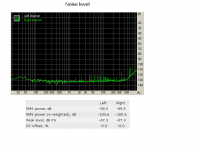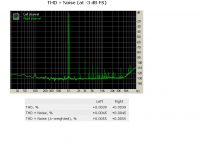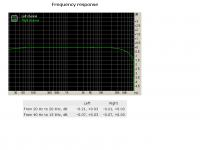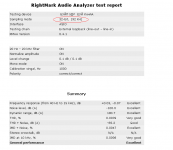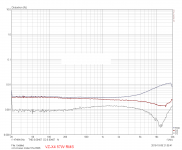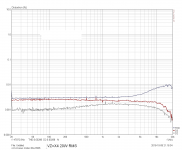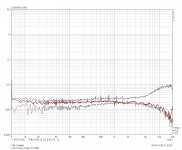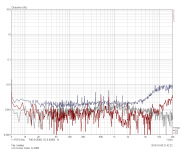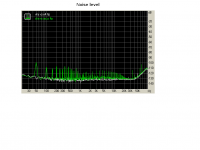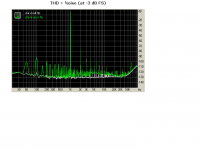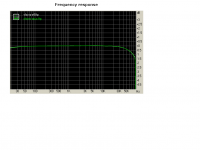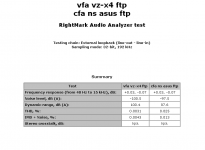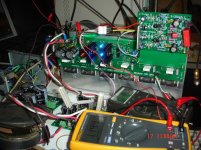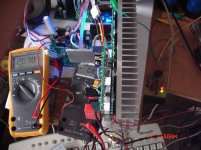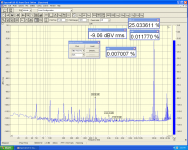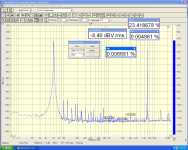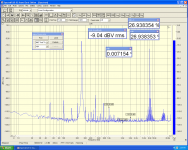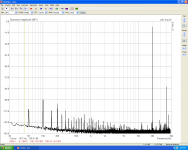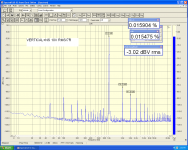Back to the amplifier please.
I wonder if any improvement expected using a separate power supply for the vas stage.
To be honest, I don't expect any noticeable improvement.
I would add a 2-pole CCS to R24 || R95 - I already have it designed, based on LM317 regulator - see attached.
Attachments
The antek transformers have a 12volt and 18 volt tap for a second vas supply.
AN-6450 - 600VA 50V Transformer - AnTek Products Corp
Their AS series have dual 15VAC windings. That's what I'm using.
Yep - pretty much as expected )
Luckily, the speaker's impedance falls down to that low level (if it does at all) at the low frequencies (below some 200-300Hz).
A good example is Thiel cs5i - a sophisticated five-way, six–drive-unit, having two 4-ohm drivers in parallel in the sub section (below 50Hz). So, we see the 2-ohm load in the range, where low-impedance-load performance is the best. Nice 😎
P.S. Thiel cs5 impedance curve is taken from Stereophile test measurements.
Bottom line is impedance, top (dashed) line is phase.
Serious stuff, demanding a "tank" amplifier 😉
Luckily, the speaker's impedance falls down to that low level (if it does at all) at the low frequencies (below some 200-300Hz).
A good example is Thiel cs5i - a sophisticated five-way, six–drive-unit, having two 4-ohm drivers in parallel in the sub section (below 50Hz). So, we see the 2-ohm load in the range, where low-impedance-load performance is the best. Nice 😎
P.S. Thiel cs5 impedance curve is taken from Stereophile test measurements.
Bottom line is impedance, top (dashed) line is phase.
Serious stuff, demanding a "tank" amplifier 😉
Attachments
EsiJulia on Asus Mobo
A little more clear results using an Asus motherboard.
A little more clear results using an Asus motherboard.
Attachments
Last edited:
Here is a comparision between vz and cfa
Interesting... looks like there is some grounding issue with CFA front-end.
Because of the low-impedance feedback network, CFA has got no ground lifting - maybe this is the reason for such a big 50 /100 Hz components difference.
VZ-X4 distortion at different frequencies
Using ARTA.
Using ARTA.
Attachments
-
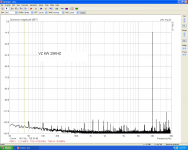 VZ 6W 20KHZ.PNG106.5 KB · Views: 136
VZ 6W 20KHZ.PNG106.5 KB · Views: 136 -
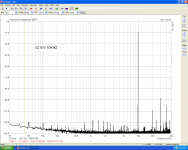 VZ 6W 10KHZ.PNG108.3 KB · Views: 135
VZ 6W 10KHZ.PNG108.3 KB · Views: 135 -
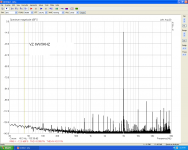 VZ 6W 5KHZ.PNG106.4 KB · Views: 135
VZ 6W 5KHZ.PNG106.4 KB · Views: 135 -
 VZ 6W.PNG106.7 KB · Views: 137
VZ 6W.PNG106.7 KB · Views: 137 -
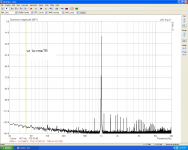 1W 1KHZ.PNG106.1 KB · Views: 361
1W 1KHZ.PNG106.1 KB · Views: 361 -
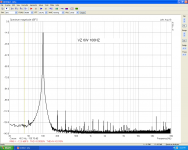 VZ 100HZ.PNG107.4 KB · Views: 365
VZ 100HZ.PNG107.4 KB · Views: 365 -
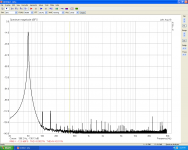 VZ 6W 50HZ.PNG107 KB · Views: 374
VZ 6W 50HZ.PNG107 KB · Views: 374 -
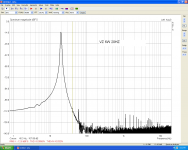 VZ 6W 20HZ.PNG115 KB · Views: 384
VZ 6W 20HZ.PNG115 KB · Views: 384 -
 VZ 6W 10HZ.PNG115 KB · Views: 406
VZ 6W 10HZ.PNG115 KB · Views: 406
Ns OPS together with the Verical IPS.
Huh! )) 1-st generation IPS with last generation OPS ))
Using RMAA
Attachments
-
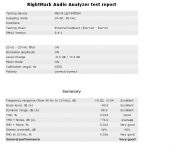 vertical IPS details.PNG22.9 KB · Views: 121
vertical IPS details.PNG22.9 KB · Views: 121 -
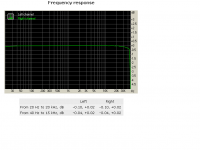 vertical frec responce.PNG21 KB · Views: 115
vertical frec responce.PNG21 KB · Views: 115 -
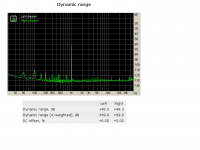 vertical dynamic range.PNG24.5 KB · Views: 108
vertical dynamic range.PNG24.5 KB · Views: 108 -
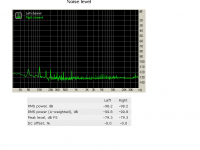 vertical noice level.PNG27.9 KB · Views: 111
vertical noice level.PNG27.9 KB · Views: 111 -
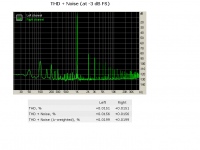 vertical THD+NOICE.PNG28.4 KB · Views: 113
vertical THD+NOICE.PNG28.4 KB · Views: 113 -
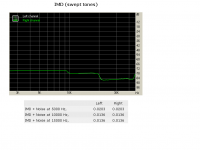 IMD SWEEP TONES.PNG21.4 KB · Views: 111
IMD SWEEP TONES.PNG21.4 KB · Views: 111 -
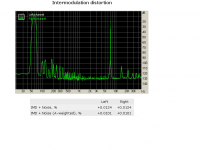 VERTICAL INTERMODULATION DISTORTION.PNG29 KB · Views: 98
VERTICAL INTERMODULATION DISTORTION.PNG29 KB · Views: 98
Jeff, please can you explain further this?It'll be interesting to see if the open input noise is still present.
What you want to test?
The first version of the Vertical CFA boards with the big NS OPS board had a 50/60hZ noise when the input was left open. Is that noise still there with this output board?
So you want an fft test leaving the inp open, or you mean a test by ears?The first version of the Vertical CFA boards with the big NS OPS board had a 50/60hZ noise when the input was left open. Is that noise still there with this output board?
Last edited:
Just a quick listening test would tell if the noise is still there. Mine had a quite noticeable 60hZ hum when the input was disconnected, but went away as soon as anything was hooked to it.
- Home
- Amplifiers
- Solid State
- Revisiting some "old" ideas from 1970's - IPS, OPS

